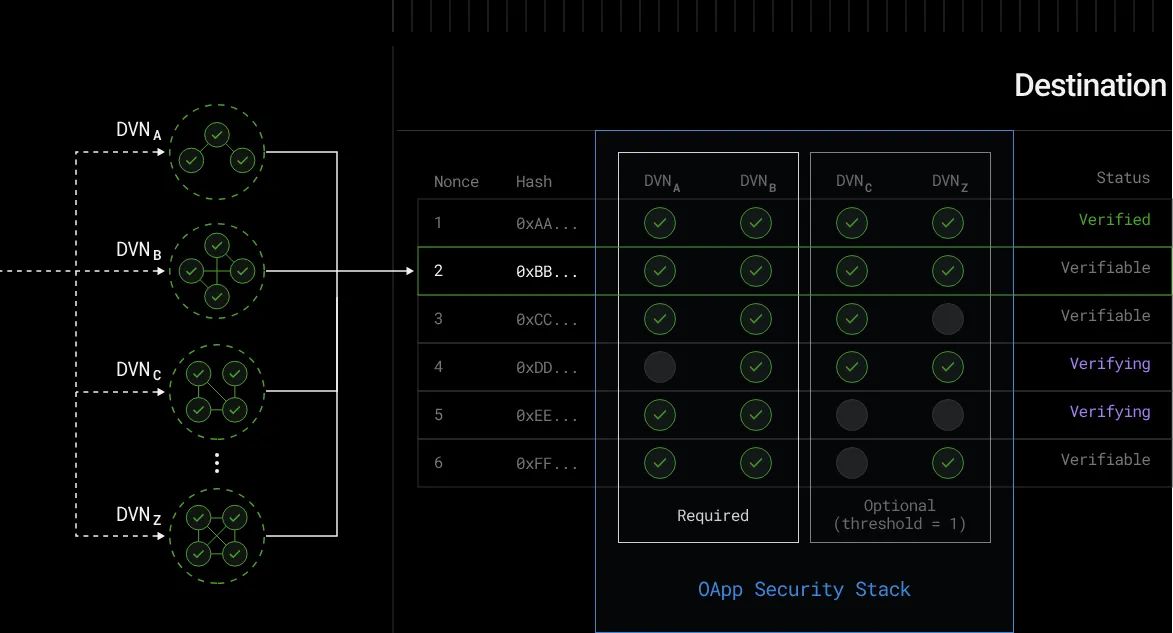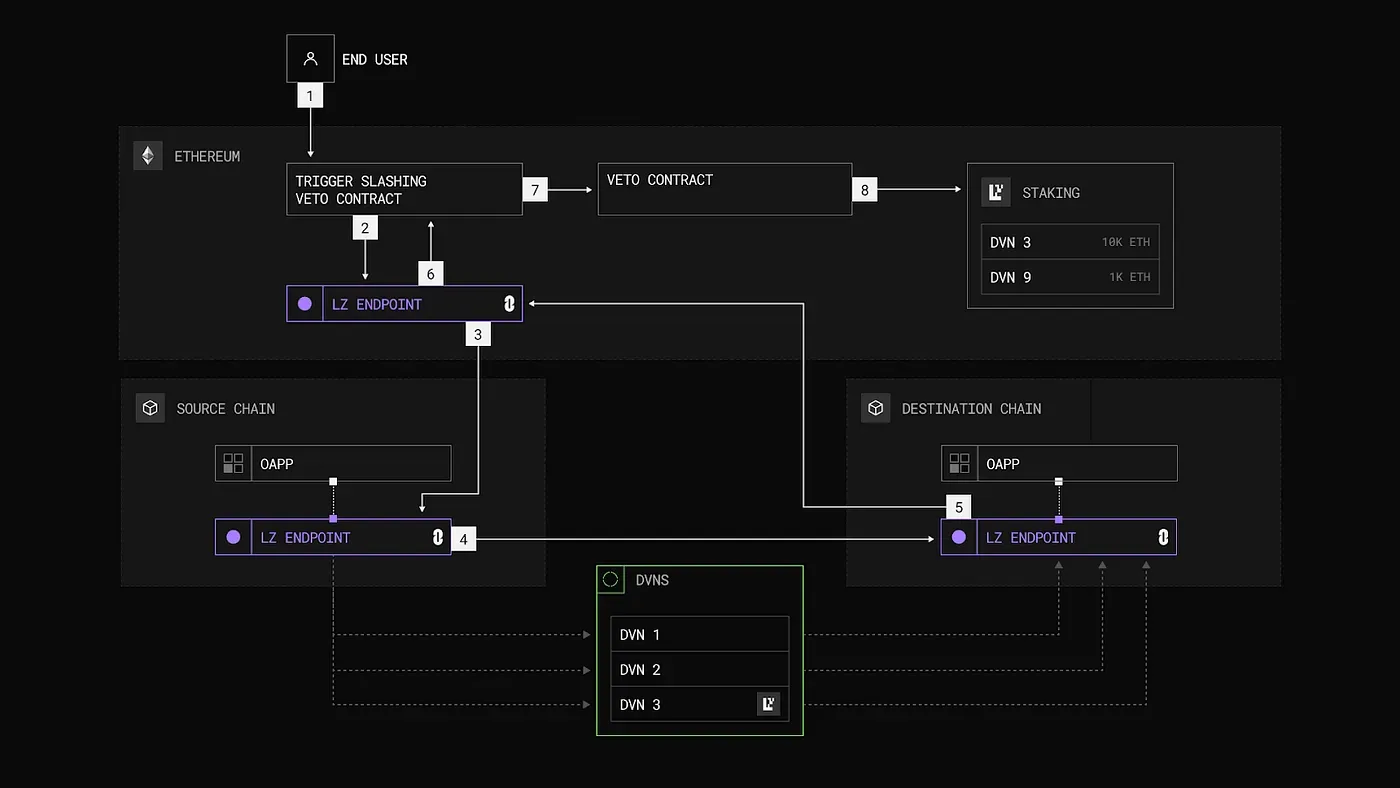LayerZero introduced its "Restaking DVN Framework," developed in collaboration with EigenLayer. This framework enables restaking to the DVN network, a verification marketplace for omnichain messaging in LayerZero. Projects can now stake token to the DVNs. By combining LayerZero's DVN with EigenLayer's customizable quorum and operator set features, projects can integrate their own tokens and governance into their omnichain security infrastructure.
What this allows is “Protocol Aligned Multichain Strategy.” Protocols can have a governance system where they can intervene and get aligned economcally in their multichain operation.
Decentralized Verifier Networks (DVNs) serves as the backbone of layerzero’s modular security model. In LayerZero V2, DVNs are responsible for verifying the integrity of cross-chain messages by checking the payload emitted during message transmission.
LayerZero allows applications to configure their own Security Stack, comprising both required and optional DVNs in a permissionless maner. This customizable approach enables OApp owners to tailor their security and cost-efficiency models to their specific needs. Each DVN can choose to employ its own unique verification schema - like PoA , zkBridge, Multi-Bridge attestation, oracle - allowing for custom security measures.

Source: Security Stack (DVNs) | LayerZero
LayerZero and EigenLayer have partnered to create the Crypto Economic DVN Framework. This system combines LayerZero's cross-chain messaging infrastructure with EigenLayer's cryptoeconomic security, financially incentivizing verifiers to act honestly.
The CryptoEconomic DVN Framework consists of four key processes:
Stake: Participants lock assets (e.g., ZRO, EIGEN, ETH) into a DVN's Actively Validated Service (AVS) as collateral.
Verify: A permissionless process checks for packet mismatches across multiple chains by sending round-trip messages, excluding potentially malicious DVNs.
Veto: If discrepancies are found, token holders have the ability to veto the stake slashing if they deem the discrepancies are due to extraneous circumstances.
Slash: If the veto confirms the packet midhandling, penalties are implemented for malicious or faulty behavior.
This framework allows any third-party DVN to implement cryptoeconomic security using various tokens, operators, and slashing rules.

Source: LayerZero x EigenLayer: The CryptoEconomic DVN Framework | by LayerZero
There's no perfect cross-chain bridge connecting all blockchains. While people often compare connecting blockchains to linking countries by plane or ship, blockchains have vastly different rules and timelines. Reorganizations can occur, and finality varies.
For protocols to expand securely across over 300 blockchains, multichain operations must align with the protocol both economically and technically. The DVN Restaking Framework enables "Protocol Aligned Interoperability," allowing protocols to have an interoperability solution that aligns with their mission and economy. It allows "skin in the game," making bad behavior costly and deterring it effectively. The framework's flexibility allows economic backing of any DVN, regardless of its underlying mechanism, and enables anyone to contribute to LayerZero message security by staking assets.
The customizable nature of DVN enables "Infrastructure-Alignment" with protocols, while Restaking in LayerZero's DVN allows "Economic-Alignment."
The economics of restaking require real-world testing. Several scenarios need consideration, such as how slashing would work after a vote on a malicious DVN. The Cosmos Hub, which uses ICS (a process for building blockchain components with restaked tokens), faced a challenge. After an incident that called for slashing, the community disagreed on whether to penalize accidental double-signing.
Protocols aim to expand their reach securely with minimal overhead. The benefit of Restaking DVN is clear - additional utility and incentive for token holders. While increased customizability offers flexibility, too many options can complicate operations. Building a "Protocol-Aligned Multichain Strategy" demands extensive research into economics and operations. With no current reference cases, it's crucial to monitor how protocols implement this DVN Restaking Framework.
The DVN Restaking Framework is a novel concept not yet implemented in existing protocols. As we enter an era of increasing number of blockchains and fatter applications, this framework will be crucial for building truly omnichain applications—both operationally and economically.
Across the different schools of thought for interoperability, the modular security design, like DVNs, is one of the most fascinating and bold. To me, different designs all have tradeoffs and there's not a one-size-fits-all solution. However, the overhead questions for the modular security design were always top of mind for me. I was never able to fully love it because of that.
With this framework going live soon, these questions are now answered. I can now happily say that I love the modular security design, and I love DVNs.
From an impact, I think this is massive. This is crypto's most powerful coordination tool (EigenLayer) embedded into the most trusted communication protocol (LayerZero).
Together, this Framework enables developers to launch cryptoeconomic dvns using any token, bringing customized security with measurable economic incentives for verifier honesty across 90+ chains. From here on out, omnichain security (or cross-chain security) is easier to evaluate, as apps see staked value and slashing conditions, making trust assumptions transparent and quantifiable. This is a big deal for us infra nerds!!
This framework also allows existing dvns to add cryptoeconomic layers, enhancing their current security models. think of it as a “yes, and” upgrade: a dvn using zk proofs can add an economic layer to its attestation, reinforcing trust.
I'll say it again -- in my opinion, this is one of the most important announcements of the year.
EigenLayer x LayerZero strengthens security for applications that exist on every chain. It is permissionless coordination: open to any DVN, any application; any operator, any token. I think the possibilities for security configurations are endless. It genuinely makes me excited about crypto and cross-chain development again. This is the way.
Related Articles, News, Tweets etc. :
Dive into 'Narratives' that will be important in the next year